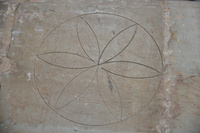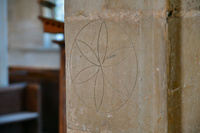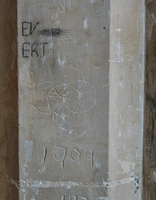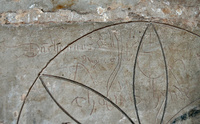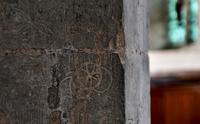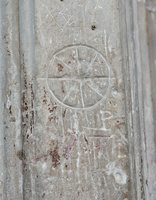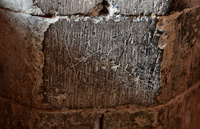On my latest medieval buildings tour I went looking for witch marks, more correctly known as apotropaic marks, which can be found in a wide variety of old buildings including churches, castles, houses and barns. Usually, they'll be found around doors, windows and chimneys and were intended to prevent a witch entering the building.
Here are a few I found yesterday...
1 is a typical Marian symbol, based on the letters M and V - Mary the Virgin. Symbols based on A and M (Ave Maria) are also common. While the MV is the most obvious in this photo, there are actually two other types as well - a pentagram (see photo 10 for more on that) and two zigzags.
2 is a very nice example of a hexafoil, which are usually said to be the most common type. However, I see MV symbols far more often which suggests to me hexafoils are just easier for most people to spot (but it should also be remembered that some MV examples are probably just a person's initials). This one is carved into one of the very few stone rood screens in Britain and was thus intended to prevent witches entering the chancel, which is believed by Christians to be the holiest part of a church.
3 is the same hexafoil as above. Since it's in such a prominent position that can be seen from most of the rest of the church and has been skillfully created most likely with a set of stonemason's compasses, it may have been officially added to the stonework with the permission of the priest.
4 is another hexafoil, rather less skillfully done. This one's in the nave where the pews are and faces away from the altar, so was probably carved by somebody during a sermon. Examples such as this, made by overlapping circles, may have been created with compasses by someone who didn't know how to use them, but since precision instruments would have been extremely expensive before the advent of mass production, I think they were probably done by using a knife or other pointed tool to trace round the edge of a circular object such as a coin.
5 Close-up of a hexafoil carved over an earlier inscription
6 Two hexafoils. The lower and more obvious one is rudimentary, the one in the top left is far better done.
7 Hexafoils created free-hand without compasses are also common and usually have six or eight spokes.
8 A very worn hexafoil. The spacing between the three rings suggests this one was created using compasses.
9 An intriguing inscription, including the word "death". The witch mark is in the top left, near the shadow of the picture frame: MW, in which the W is two Vs (W was commonly used this way in Old and Middle English) - Mary, Virgin of Virgins
10 Numerous other symbols are used too, including the saltire and a rectangular eight-spoked design which resembles the British flag. Also common is the pentagram, which only gained its association with black magic and evil relatively recently. One of the oldest of all apotropaic symbols, it's thought to have first been used in this way in around 3000BCE.
Not many people know about apotropaic marks, but they were used right into the 19th Century and possibly, in some areas, even later. They're common in Europe but can also be found in the Americas and other regions settled by Europeans from medieval times onwards.

Enjoy being online again!
Welcome to the community of good people who base their values on evidence and appreciate civil discourse - the social network you will enjoy.Create your free account
10 comments
Feel free to reply to any comment by clicking the "Reply" button.Have seen many similar bits of inscription around here, but never knew the meaning - thanks for the information - very interesting
I find this type of stuff very interesting thanks for posting it
Super post. They may have used beam compasses which are easy to make for the circles. They were probably used to make cup and ring marks 2000 years before. I tried to like your posting but for some reason agnost.com won't allow it.
Jnei:
Yes, a beam compass would be my first thought too.
Great photos and wonderful information. Thanks!
Enjoy being online again!
Welcome to the community of good people who base their values on evidence and appreciate civil discourse - the social network you will enjoy.Create your free account
Share this post
Categories
Agnostic does not evaluate or guarantee the accuracy of any content. Read full disclaimer.

